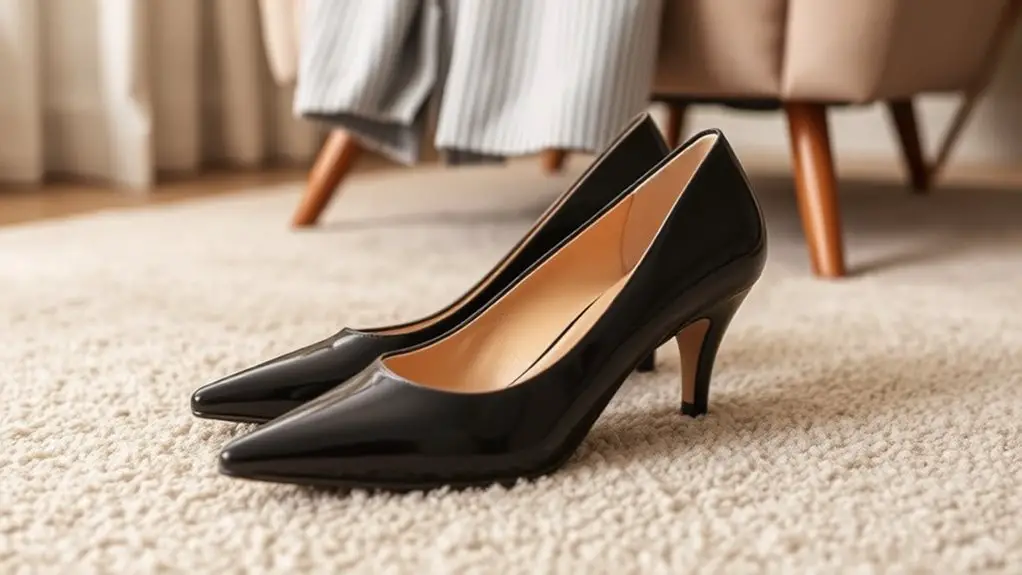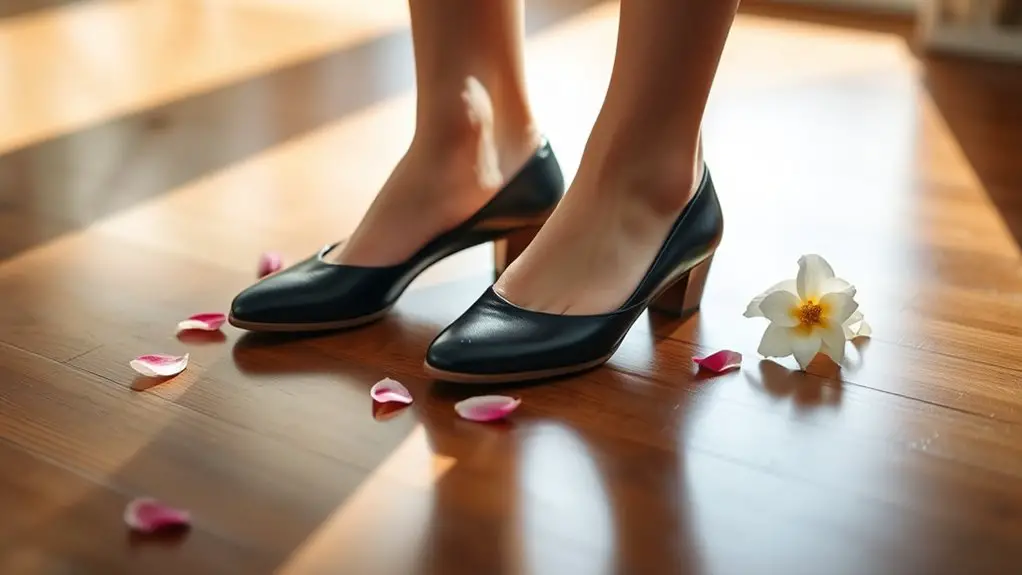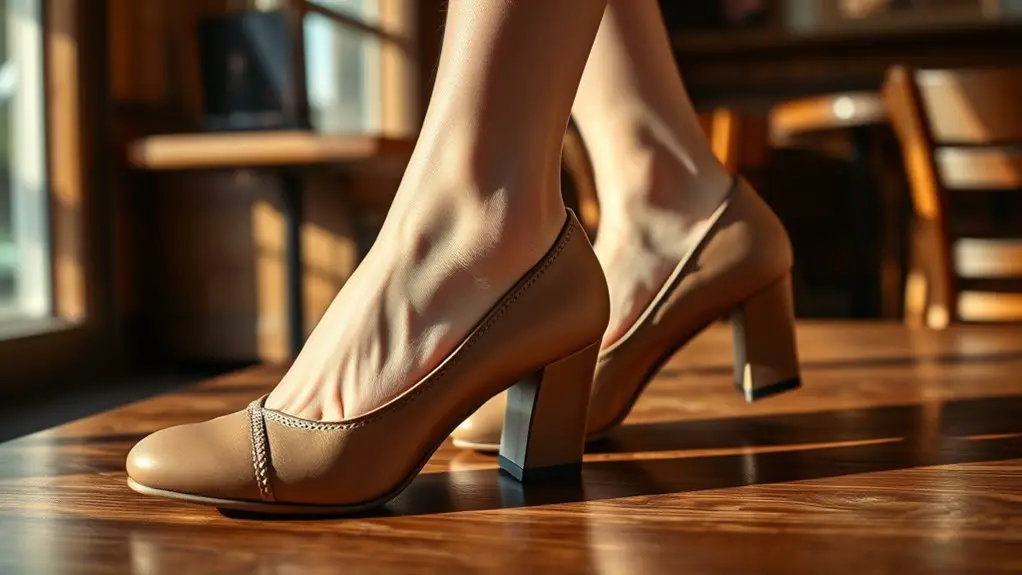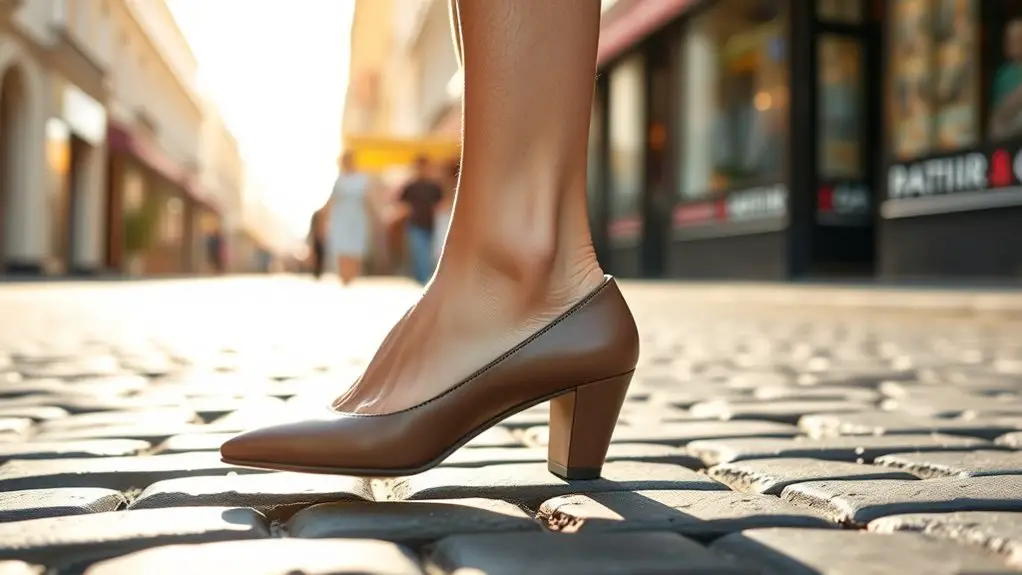The best heel height for all-day wear typically ranges from 1 to 2.5 inches, striking a balance between style and comfort. Low heels offer versatility and support, while mid-heels enhance elegance without sacrificing comfort. High heels can elevate your look but may not provide the same all-day wearability. Always consider factors like cushioning and shoe materials for added comfort. If you want to learn how to choose the right heel for various occasions, keep exploring!
Understanding Heel Heights: The Basics

When it comes to selecting the right heel height for all-day wear, understanding the basics is vital. You’ll encounter various heel types, each offering distinct characteristics and benefits. For instance, kitten heels are typically around 1.5 inches, providing a slight elevation while maintaining comfort. On the other hand, block heels can range from 1 to 3 inches, offering stability and support.
Height variations also play a significant role in your choice. Low heels are ideal for long hours on your feet, whereas mid- to high heels can elevate your look but may become uncomfortable over time. It’s important to take into account the heel’s shape and width, as these factors contribute greatly to your overall comfort. By familiarizing yourself with these heel types and height variations, you can make an informed decision that suits both your style and your needs throughout the day.
The Comfort Zone: Ideal Heights for Everyday Wear
Finding the perfect heel height for all-day wear often comes down to a sweet spot between comfort and style, typically ranging from 1 to 2.5 inches. This height accommodates most comfort preferences while allowing you to maintain a polished look. Heels within this range provide enough elevation to elongate your legs without compromising stability, essential for daily routines that require mobility.
When selecting heels, consider how long you’ll be on your feet and the surfaces you’ll navigate. For instance, a 2-inch heel strikes a balance, offering a slight lift without sacrificing comfort. If you’re running errands or at the office, those extra inches can make a difference in posture and fatigue levels.
Ultimately, the best heel height is one that aligns with your comfort preferences while seamlessly fitting into your daily activities. Prioritize finding styles that feel good and look great, so you can conquer your day effortlessly.
Low Heels: The Unsung Heroes

When it comes to all-day wear, low heels are often overlooked, but they’re true champions of comfort. You’ll find that they offer versatile style options, making them suitable for various occasions while providing the support your feet need. Choosing low heels can transform your wardrobe without sacrificing comfort, ensuring you stay stylish and pain-free throughout the day.
Comfort for Long Hours
Although many people equate style with high heels, low heels often emerge as the unsung heroes for all-day comfort. Their ergonomic designs provide essential support, allowing you to navigate through your daily routines without discomfort. With a lower heel height, your feet maintain a more natural position, reducing strain on your ankles and lower back. This design not only alleviates pressure but also promotes better posture throughout the day. Whether you’re at the office, running errands, or enjoying a night out, low heels guarantee you stay comfortable from morning to evening. Investing in quality low-heeled shoes can make all the difference, enabling you to focus on what matters most without the distraction of aching feet.
Versatile Style Options
While many might think high heels dominate the fashion scene, low heels offer a surprising range of versatile style options that can elevate any wardrobe. You can effortlessly shift from a day at the office to an evening gathering with a chic pair of low-heeled shoes. For a polished office chic look, opt for sleek low-heeled pumps paired with tailored trousers or a pencil skirt. When aiming for dressy casual, consider strappy low-heeled sandals or elegant loafers that complement your favorite midi dress. These styles not only provide comfort but also enhance your outfit’s overall aesthetic, making low heels the unsung heroes of versatile fashion. Embrace the charm of low heels and reveal endless outfit possibilities!
Supportive Footwear Choices
Choosing the right footwear is vital for all-day comfort, and low heels emerge as a top contender for supportive options. They typically feature an ideal heel height that provides stability without compromising style. Low heels often incorporate arch support, which is important for maintaining foot health. This support helps distribute your weight evenly, reducing strain on your feet and lower back.
When selecting low-heeled shoes, look for styles with cushioned insoles and a wider toe box. These features enhance comfort and prevent common foot issues. Brands that prioritize design and function will guarantee you can wear them throughout the day without discomfort. Ultimately, choosing supportive low heels can keep your feet happy while still looking chic.
Mid-Heels: Balancing Style and Comfort

When it comes to finding the perfect pair of heels for all-day wear, mid-heels often strike the ideal balance between style and comfort. Typically ranging from 2.5 to 3.5 inches, these heels provide enough elevation to enhance your outfit without compromising stability. You’ll find a variety of mid heel styles, from classic pumps to trendy block heels, catering to different tastes and occasions.
The choice of mid heel materials also plays a vital role in comfort. Leather and suede offer breathability and flexibility, while synthetic options can provide added cushioning. Look for features like padded insoles and arch support, which can make a significant difference during long hours of wear. By selecting the right mid heels, you can enjoy both elegance and comfort, making them a versatile choice for your daily wardrobe.
High Heels: When to Choose Them
Mid-heels offer a comfortable option for everyday wear, but there are occasions where high heels can elevate not just your height but your entire look. For elegant occasions such as weddings, galas, or formal dinners, high heels can add a touch of sophistication that complements your outfit. Choosing the right pair can enhance your personal style, making you feel more confident and poised.
When selecting high heels, consider the event’s formality and your outfit’s design. A sleek stiletto can add drama to a cocktail dress, while a block heel provides stability without sacrificing elegance. Remember, the key is to find a balance between style and comfort; your heels should empower you rather than hinder your movement.
Ultimately, high heels can be a powerful tool in your wardrobe, defining your silhouette and enhancing your overall presence at special events.
The Importance of Arch Support
While many prioritize style when selecting footwear, the importance of arch support cannot be overstated, especially for those who spend long hours on their feet. Arch support benefits include reducing fatigue and discomfort, allowing you to maintain energy throughout your day. When shoes provide proper alignment, they help distribute your body weight evenly, minimizing strain on your feet, knees, and back.
Without adequate arch support, you may experience issues like plantar fasciitis or general soreness, which can detract from your daily activities. By choosing footwear that offers solid arch support, you’re investing in your overall health and comfort. This is especially essential for individuals with specific foot types, like flat feet or high arches, as their needs differ greatly. Prioritizing arch support guarantees that you can enjoy your time on your feet without sacrificing style for comfort.
Materials Matter: Choosing the Right Shoe
Choosing the right shoe goes beyond just arch support; the materials used in footwear play a significant role in comfort and durability. When selecting shoes, consider these key factors:
Selecting shoes involves more than arch support; material choice is crucial for comfort and durability.
- Fabric Types: Different materials like leather, mesh, and synthetic fabrics offer varying levels of breathability and moisture control.
- Sole Cushioning: Proper cushioning absorbs impact and supports weight distribution, reducing fatigue during all-day wear.
- Flexibility Levels: Look for materials that allow natural foot movement without compromising support.
- Durability Concerns: High-quality shoe materials enhance longevity, ensuring your investment lasts.
How to Break In New Heels Safely
Breaking in new heels doesn’t have to be a painful experience if you follow a few key steps. Start by ensuring you’ve got the right size and gradually increase your wear time to allow your feet to adjust. Adding protective inserts can also enhance comfort, making all-day wear much more enjoyable.
Choose the Right Size
Finding the right size is essential when it comes to breaking in new heels safely. Proper shoe sizing guarantees comfort and reduces the risk of blisters or discomfort. Here’s how to measure your feet accurately:
- Measure both feet: Your feet may vary in size, so always measure both.
- Use a Brannock device: This tool gives precise foot measurements, including width.
- Try on shoes at the end of the day: Feet swell throughout the day, making this the best time to select your size.
- Walk around in the store: Confirm there’s enough room at the toe box and that your heel doesn’t slip.
Choosing the right size will make breaking in your new heels a much more pleasant experience.
Gradual Wear Schedule
As you start to wear your new heels, it’s essential to implement a gradual wear schedule to guarantee comfort and prevent injury. Begin by wearing your heels for short periods, around 30 minutes to an hour, to allow your feet to adjust. Each day, increase the time you wear them slightly, aiming for a gradual increase of 15 to 30 minutes. This method promotes heel adaptation, giving your feet the chance to strengthen and become accustomed to the heel height. Pay attention to any discomfort or pressure points, as these signals indicate when to take a break. By following this schedule, you’ll secure a smoother progression into your heels, allowing for more comfortable all-day wear.
Use Protective Inserts
While acclimating to your new heels, using protective inserts can greatly enhance comfort and support. They provide essential arch cushioning and improve heel stability, making your change smoother. Here are four types of inserts to take into account:
- Gel Cushions – These provide excellent shock absorption and reduce pressure on your feet.
- Arch Supports – Designed to maintain proper foot alignment and alleviate discomfort during prolonged wear.
- Ball-of-Foot Cushions – These target the forefoot area, reducing the pain that often accompanies high heels.
- Heel Grips – They prevent slipping and enhance fit, ensuring that your heels stay securely in place.
Incorporating these inserts will help you break in your heels safely and enjoy them all day long.
Styling Tips for Different Heel Heights
How can you best style your outfit around different heel heights? Understanding heel pairings is essential for creating stylish outfits that feel comfortable throughout the day. Here are some tips for various heel heights:
| Heel Height | Best Outfit Pairing |
|---|---|
| Flat Shoes | Casual dresses or tailored pants |
| Low Heels (1-2″) | A-line skirts or cropped jeans |
| Mid Heels (2-3″) | Pencil skirts or fitted trousers |
| High Heels (3″+) | Maxi dresses or wide-leg pants |
For flats, opt for relaxed styles to maintain balance. Low heels complement tailored pieces, while mid heels add sophistication to work attire. High heels elevate your look for special occasions but consider the overall outfit for cohesion. By mastering these styling tips, you can confidently mix and match your outfits with the perfect heel height.
Listening to Your Feet: Signs You Need to Switch It Up
Recognizing when your feet are signaling the need for a change in footwear is essential for maintaining comfort and overall foot health. Ignoring discomfort can lead to foot pain and long-term issues. Here are some signs it’s time to switch it up:
Recognizing your feet’s signals for new footwear is key to comfort and foot health. Ignoring discomfort can lead to lasting issues.
- Persistent Discomfort: If you feel consistent pain after wearing a specific pair, it’s a clear sign to reassess your choice.
- Numbness or Tingling: Experiencing these sensations can indicate that your shoes are too tight or poorly fitted.
- Changes in Your Gait: If you’re walking differently or favoring one foot, it’s time to evaluate your shoes’ support.
- Lack of Confidence in Style: If your shoes no longer match your style preferences, you might be subconsciously avoiding them.
Listening to your feet can guarantee you stay stylish and comfortable, helping you maintain both foot health and confidence.
Frequently Asked Questions
How Do I Choose Heels for Specific Occasions?
Imagine you’re dancing at a wedding; you’ll want comfortable, stylish heels. For formal occasions, opt for classic pumps. For parties, try block heels. Consider the occasion styles and heel types to guarantee you feel confident.
Can Heel Height Affect My Posture?
Yes, heel height can greatly affect your posture. Higher heels often tilt your pelvis forward, leading to potential back pain. Choosing the right heel height is essential for maintaining proper alignment and overall comfort throughout the day.
What Are the Best Brands for Comfortable Heels?
Imagine slipping on a pair of stunning heels for an evening out. Brands like Clarks and Naturalizer offer comfortable brands with stylish options, ensuring you look fabulous without sacrificing your feet’s comfort during long wear.
How Can I Prevent Blisters From Heels?
To prevent blisters from heels, consider these blister prevention tips: wear moisture-wicking socks, choose comfortable heel options, and use blister pads. Also, make certain your shoes fit well to reduce friction and irritation throughout the day.
Are There Any Exercises to Strengthen My Feet for Wearing Heels?
Yes, there are effective foot exercises you can do. Strengthening your arches through toe curls and calf raises can enhance arch support, making it easier to wear heels comfortably for extended periods.



